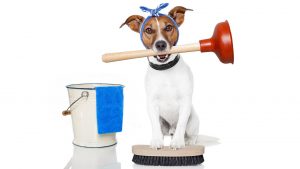
This article comes from the Dog Cancer Blog
by Molly Jacobson
Dealing with dog cancer is, let’s face it, totally overwhelming. There are so many things to keep track of and learn about: supplements, diet, medical interventions, lifestyle changes. I know the last thing you probably want to do is learn about making homemade cleaning supplies.
And yet, you’ll be glad you did. Here’s why:
- Reducing the toxin burden in your home from chemicals found in cleaning supplies will greatly reduce the toxic burden your dog has to deal with.
- Reducing the toxin burden in your home will greatly reduce the toxic burden YOU have to deal with.
- Making homemade cleaning supplies is surprisingly easy, dead simple, and kind of fun.
- For all but the most extreme cleaning jobs, homemade cleaning supplies do everything you need and smell great.
Why You Want to Reduce Your Reliance on Commercial Cleaning Products
As Dr. Dressler points out in chapter 8 of The Dog Cancer Survival Guide, there are many carcinogens (cancer-causing agents) in the air, water, soil, and food supply. Avoiding all toxins is pointless because even if we lived in a bubble, the materials made for the bubble are probably plastic, and therefore likely carcinogens. Most likely, you just can’t “move away” from toxins.
So instead of trying to avoid ALL carcinogens, the wise dog lover tries to REDUCE the number of toxins we (and of course our dogs) encounter.
Why? Because a dog dealing with cancer is already dealing with too much. Throwing more toxins at them just overworks their immune system and liver, causes undue stress, and stops them from being able to heal as well.
Extra carcinogens may also make cancer even worse than it already is.
But aren’t cleaning products by their very nature, not toxic? Aren’t they CLEAN?
Argh. No, sadly. While we’re not very good at assessing the long-term effects of using chemical cleaning agents, we definitely know that long-term use can be damaging. The use of chemicals in cleaning products is not regulated the way body care products are, or food products are. Companies don’t have to leave out carcinogens, because these products aren’t designed to be used directly on the body.
But if your dog is like mine, she sniffs and licks just about everything — and therefore IS exposed to chemicals in the cleaning products I use. Probably even more than I am.
And we know from the Environmental Protection Agency’s work on Indoor Air Quality that getting rid of toxins in the home is vital for all of us — even those who aren’t actively dealing with side effects from home chemicals.
That’s why I’ve been making my own cleaning supplies, for the most part, for years now. And I’ve found that I feel better, too. Cleaning is no longer a hold-your-nose job. My hands don’t itch or get rashy afterward. And while some jobs still require chemicals, it’s pretty rare I call on them.
I don’t claim to be a Homemade Cleaning Supplies Expert, but I know enough to get you started. So let’s take a look.
Basic Ingredients You Need for Homemade Cleaning Supplies
Most ingredients you’ll use to clean your home cheaply and naturally are super inexpensive, easy to find, and easy to store. Most recipes in this article and other articles you’ll find online feature a combination of the following items:
Baking Soda
Baking soda is, quite simply, awesome. It can be used as a mild abrasive, cuts through grease and grime like a dream, cleans, deodorizes, and was even used by old-school docs to fight cold and flu viruses.
White Vinegar
Vinegar is an acid, making it invaluable for cleaning. If you only had vinegar on hand, you could clean just about anything, from your grill to your laundry. Vinegar cuts through grease, soap scum, and grime. Great in the laundry, too.
Hydrogen Peroxide
You might have a brown bottle of this stuff for disinfecting cuts — but it can do the same thing for your drains, grout, toilet bowls, and moldy areas. Hint: brown bottle is for external use, white bottle is food-grade. Don’t mix the two up!
Castile Soap
This style of soap is liquid and made from 100% plant oils, which makes it super-safe for home use. I love Dr. Bronner’s*, and buy it in all the different scented formulas so that my homemade cleaning supplies smell delicious.
Essential Oils
Essential oils certainly make your homemade cleaning supplies smell good, but their use can go beyond aromatherapy, as some have anti-bacterial and anti-viral properties. Some of my favorites to include are tea tree oil, lemon, lemongrass, peppermint, and lavender. Any citrus blend is lovely, too. Choose scents that make you feel happy — and if you have an essential oil adviser, they will have lots of ideas about which oils to use for housecleaning, and why they’re helpful. Just a couple of drops in a recipe will do it.
I am not advocating using essential oils directly on your dog, because I’m not a vet, and I don’t know how to advise you about that. There are many people who use essential oils topically, but I would absolutely not do that if you don’t have someone supervising you. (I have used essential oils for my own topical use for years, and I’ve never once used them on my dogs because I am concerned that they are too intense for them.)
If you use essential oils in products you use on your floor — for example, if you use a scrubbing paste to scrub your tile, either skip the essential oils altogether or use only lavender in your paste or spray. That’s a really gentle oil we know is safe for dogs.
There are many companies that now make essential oils, so I’m not going to play favorites. I have used oils from all of the following companies:
- Good brands for housecleaning that you can get at your local health food store include NOW, Aura Cacia, Healing Solutions, and Edens Garden, among others.
- Young Living and doTERRA both make good quality oils, but they are multi-level marketing companies (also called network marketing) and you need to find a rep to buy from them.
- Mountain Rose Herbs* and Rocky Mountain Oils* are both excellent oil manufacturers that sell direct to consumers online.
Olive Oil
Yes, the oil you have for cooking can also clean and polish!
Must-Have Tools for Homemade Cleaning Supplies
There are just a few things you’ll need to use with homemade cleaning supplies. You might have these already, but just in case:
Spray Bottles
You will need something to store your homemade cleaning supplies, and these plastic spray bottles are some of the best*. They last a looooong time before the sprayer starts to lose its might, and that’s key. I also like that they are smaller sized, which makes them easy to fit in my caddy.
Note: some folks think you should only use glass bottles for cleaning supplies, to keep them totally free of any plastics. That’s probably right. But I haven’t found a glass spray bottle that feels safe enough to me. They get slippery, and I drop them, and after one shattered, I was done. The slight risk of plastic leaching into my cleaning supplies isn’t worth the risk of my butterfinger acting up again. Instead, I just make smaller batches of cleaning fluids!
Tubs
I like little covered glass dishes* or even canning jars* for scrubbing pastes. (I don’t pick these up as much as spray bottles, so I feel safe using glass.)
I use small containers, usually 4 ounces, so I can have a little jar near every sink in the house, making it easy to scrub out any time I see something yucky.
Carrying Caddy
This is just a general tip: use a carrying caddy* for your supplies. It will really help you to keep organized.
Microfiber Towels
I was raised to dust with old t-shirt rags, and it was hard to get me to try a microfiber towel* instead. But man, I’m glad I did. It holds so much more dust, especially if you use it damp, is easier to clean, and lasts forever. Totally worth the cost! I now have a whole wardrobe of cleaning towels, for stainless steel*, mirrors/glass*, and more. Just using these towels alone can often do MOST of the cleaning job — without anything other than water! Wash these towels on gentle, cold water, and dry without dry cleaning sheets and they last for years.
Microfiber Dusters
Another tool I poo-pooed at first. But it’s now possible for me to remove 80% of the dust from my home within half an hour, just because I keep these cleaning wands* on hand. They grab the dust and don’t let it go. I can reach to clean the back of the TV, the slatted blinds, and the corners. The microfiber can be washed in the gentle cycle (air dry) and when it’s really gone, replaced.
Pre-Cautions About Homemade Cleaning Supplies
Word of warning: just because something is natural doesn’t mean it is totally safe. Here are some things to keep in mind as you make and use your supplies:
- Not all ingredients “get along.” For example, vinegar is used all over the place, but when mixed with other common ingredients, the result can be less than useful.
- Vinegar plus baking soda basically cancel each other out. Vinegar is an acid, and baking soda is a base, so when they meet they fizz up as they combine to make, essentially, salty water. The fizzing can help unclog a drain (see below) and clean a toilet bowl, but they don’t make a super cleaner when combined. They are both separately great cleansers, though, so using them back to back can be really helpful (see the grout cleaner recipe).
- Vinegar plus castile soap is also sort of a useless combo. When you combine the acid (vinegar) and base (soap) you get … soap. But not the nice, luxuriously silky soap you started with. Instead you get a kind of oily, curdled cottage cheese-like soap. Gross, and no longer useful for cleaning.
- Vinegar and hydrogen peroxide is a different story — this combo is NOT useless, it’s dangerous. Combining these two powerful disinfectants creates a type of acid that is pretty irritating to the skin and eyes, and personally gives me an asthma attack within a minute or two. No good in combination. But used back to back (see grout) they can really whiten up the place!
- Clean your tools. When you finish a bottle of homemade cleaner, don’t just refill it — sanitize it first. Bacteria introduced into homemade cleaning supplies is not guaranteed to die a good death.
- Trust your eyes and nose. If that batch of homemade scrubbing paste or bottle of cleanser has a weird color or smell, it’s done. Don’t use it — throw it away, and make a new batch. That goes for commercial products, too, of course. Cleaning supplies can and will get slimy or smelly if left unused!
- Label everything. Today, you’ll remember which bottle holds straigh hydrogen peroxide and which holds vinegar cleanser. But next week? Not a chance. Everything we make at home is basically colored white or clear — so label your bottles. I also add the date I made the batch to the label, so I don’t wonder how old it is later.
- Use safe water. For anything you’re putting in a bottle and using over time, using distilled water will ensure it’s not contaminated. If you’re just rinsing your tile, using clean tap water is fine — but if you’re making a cleaner you’ll be using over time, do yourself a favor and use distilled water from the store. Or, if you’re out, boil tap water for 15 minutes to disinfect it, and then cool before combining with other ingredients.
- Spot test. Even though these recipes are generally gentle, that doesn’t mean they are safe to use on every surface. Delicate surfaces like wood, floors, carpets, and counter tops might not react well to even the gentlest of cleaning supplies. So spot test in a small, inconspicuous area before you use any solution for the first time.
- Wear gloves when cleaning up after your dog on chemotherapy. As Dr. Ettinger reminds us in this article, your dog on chemo is definitely shedding some chemo drugs in their urine and feces in the days following chemotherapy. She says at least three days, but for some drugs, it can be even longer. Please follow her precautions at home, and if your dog has an accident in the house, make sure you are wearing gloves — and maybe even a face mask — when you clean it up. A mild cleanser like the ones I describe below should be used to clean, but you should probably wash carpets, floors, and countertops three times, just to make sure you remove the problem. I would use paper towels for jobs like this, and dispose of them in a tightly sealed bag immediately. If you use a microfiber cloth, I would throw it out rather than try to reuse it later.
Homemade Cleaning Supplies: Recipes
Here’s a secret I learned from a housecleaner: most things can be cleaned with an all-purpose cleaner. Here are two “all-purpose” cleaners that can be used for everything from mirrors to wiping down toilets, because they cut down grime, disinfect, and smell good. I would not use them on wood, stone, or floors, though.
H2O2 All-Purpose Cleaner
Ingredients:
- 2 cups water (distilled if you live in a hard water area)
- 1 cup hydrogen peroxide (brown bottle)
- 1/4 cup lemon juice
Mix in a spray bottle and use everywhere you need a gentle cleanser. Hydrogen peroxide is great in the shower to fight mold, too!
Vinegar All-Purpose Cleaner
Ingredients:
- 1 part white vinegar
- 1 part water
- essential oils for nice smell OR lemon rind, or rosemary sprig
Mix in a spray bottle use. If you are using lemon rind or rosemary, you will need to let it sit and infuse for a week to get a really lovely smell out of it. This is a great general cleaner you can use on everything from tile to spot cleaning carpets. Vinegar fights mold, so I use this in the shower, too.
Stone Cleaner
The all-purpose cleaners above will work for just about any surface except for stones like granite, marble, or slate. Those surfaces are much more delicate and just can’t handle the acidic nature of vinegar and citrus.
For stone surfaces, I use a couple drops (maybe a teaspoon) of dishwashing liquid (non-citrus!) and 2 cups of warm water, mixed in a bowl. Then I use a sponge to gently clean the stone, and buff dry with a microfiber cleaning cloth. Make sure to completely remove the soap residue, or your stone will suffer!
In terms of polishing, the only way to keep the stone really safe is to reseal it every year, better every six months. Sealers are generally not DIY material. But regularly cleaning with gentle cleansers like this can keep your stone clean, so when you do reseal it, it’s still beautiful.
Mirror and Glass Cleaner
For daily cleaning, I usually just use isopropyl (rubbing) alcohol in a spray bottle and a microfiber mirror cloth to clean both mirrors and glass. That stuff cuts through everything and does NOT leave streaks. But it can also really dry out my hands if I am doing a lot of glass work — so when I clean windows, I usually make myself a glass cleaner. Here’s a good recipe:
Ingredients:
- 1/4 cup white vinegar
- 1/4 cup isopropyl alcohol
- 1 tablespoon cornstarch
- 2 cups water
- 8-10 drops of your favorite essential oils (optional)
Mix everything in a spray bottle and shake well before you spray. If you don’t shake well, the cornstarch won’t be integrated, and that’s what reduces streaking the most.
Wipe clean!
Wood Polish
I’m a sucker for beautiful wood, so I like to polish mine. Here’s an easy recipe to use at home. This is a small batch because you won’t need much in any given day, and olive oil goes rancid over time. If I have any left over, I use it as a base for that night’s salad dressing.
Ingredients:
- juice of 1 lemon
- 1 tablespoon olive oil
- 1 tablespoon water
Mix in a small jelly jar, put the lid on the jar, and shake it until it’s all emulsified. Dip your microfiber cleaning cloth into the polish and use sparingly, buffing the wood with a separate clean, dry microfiber cloth.
Silver Cleaner
My favorite! Commercial silver cleaners are GROSS. Here’s how to clean silver totally naturally with CHEMISTRY!
Ingredients:
- boiling water
- baking soda
- tin foil
Place a sheet of tinfoil in a wide shallow pan — I use a 9×12 baking dish — so that the tin foil covers the bottom. Set your silver in the pan, and don’t crowd it, because in order for this to work there needs to be open water around each piece.
Pour the boiling water into the pan, submerging the silver completely.
Sprinkle baking soda slowly over the silver. It will fizz and bubble, as the baking soda interacts with the tin foil and the tarnish. Keep sprinkling baking soda until all fizzing stops.
Remove the silver from the pan with tongs (it’s hot!) and wash with dishwashing liquid and warm water to remove all the baking soda. Super clean, sparkly silver!
And look at that tin foil — it’s now covered with tarnish! So cool.
If you have more pieces to do, simply repeat the process, making sure to use new foil and new boiling water. Some folks use the aluminum pans instead to save time, but I have a lot of silver …
Scrubbing Paste for Sinks, Stovetops, Tubs, and Tile
Here’s an all-natural replacement for your “soft scrub” cleaner. I love using this anywhere I need a little extra degreasing and a little extra abrasive power. Sinks, stovetops, tile floors, glass shower doors all come clean after being treated with this scrub. I have a little jar of this paste in my kitchen, bathrooms, and laundry room.
Ingredients:
- 1/3 cup baking soda
- castile soap (I like peppermint for this)
- essential oils (optional)
- jelly jar or storage jar with lid
Put baking soda in your storage container, and add castile soap to it and mix until you get a smooth, thick paste. Dip your sponge or brush into the container and use everywhere you would any commercial paste cleaner. Rinse with warm water.
This paste will keep for a long time with a lid.
Drain Cleanser
This won’t necessarily clear big clogs (Zep* will) but it’s useful for freshening garbage disposals and opening drains all over the house.
Ingredients:
- 1/4 cup baking soda
- 1/4 cup vinegar
Sprinkle baking soda down the drain, and pour vinegar in after it. The fizzing will be phenomenal, but that combo will eat through lots of issues! Let it sit for an hour, and then pour boiling water down the drain to rinse it. If you do this regularly, the likelihood of a big clog will definitely go down.
Keep in mind that the effectiveness of this cleaner is likely the REACTION of fizzing you get when you combine the acid vinegar with the base baking soda.
Carpet Freshener
Before vacuuming, sprinkle baking soda all over your carpet. Let sit for half an hour, and vacuum. If you like a fresh scent, I get dried lavender flowers from the bulk section of my local health food store and mix them into the baking soda before sprinkling. It really works!
Toilet Bowl Cleaner
Honestly, I get squeamish around toilet bowls, so I sometimes use a bleach commercial cleaner to make sure I’m really keeping it clean in there, especially if it’s been a while. But for general cleaning, I have no problem with using this combination:
- 1/4 cup baking soda
- essential oils (optional, but tea tree oil is great for this)
- 1 cup vinegar
Mix baking powder with essential oils (about a teaspoon) in a glass bowl. Put about a tablespoon of the baking soda mix (or just plain baking soda, if you aren’t using oils) into the water in the bowl. Sprinkle the rest of the powder around the bowl itself and use your toilet brush to spread the powder and scrub your bowl.
Pour vinegar into the toilet and let the mix fizz. Use the brush to clean the bowl again, and then let it sit for 15 minutes or more, if necessary. Flush, and you’ve got a sparkly, disinfected toilet bowl!
If not, just scrub out your bowl with the scrubbing paste above. It will take care of everything.
Grout Cleaner
I hate dirty grout. To clean it, I use a grout cleaner brush* that holds the exact right angle so I don’t give myself a shoulder injury, and the following method:
- Sponge straight vinegar onto the grout, let sit for five minutes
- Take some of my scrubbing paste (above) and dip my brush into it. Scrub the grout, allowing the baking soda in the paste to fizz with the vinegar on the grout and work it in.
- Rinse with warm water.
- If necessary, follow up with a squirt or two of hydrogen peroxide, let it sit, scrub again (make sure to clean the brush first so the soda and vinegar are gone), and rinse with warm water.
Microwave Cleanser
This could not be easier!
- Put one or two cups of water in a measuring cup or ceramic bowl, and add 1 tablespoon of vinegar.
- Microwave until about half the water has evaporated.
- Wait 10 minutes, so the vinegar-steam can work on the crusted surface of the oven.
- Open door and carefully remove the bowl (it will likely still be hot).
- Wipe the walls with a damp sponge, and if you have baked on stains that don’t come off easily, sprinkle the sponge with a little baking soda, and they’ll come off pretty quickly.
- Wipe down the walls again with a clean damp sponge to remove all traces of soda or vinegar.
Disinfect Cutting Boards
Put hydrogen peroxide (food grade — white bottle) in a sprayer and spray on cutting boards to kill germs and bacteria. Let sit to penetrate. I do this before I oil my boards.
You can also use a half a lemon to do the exact same thing — just cut the lemon in half and rub the cut surface over the cutting board to disinfect it. Let sit for a few minutes, and then oil the boards.
Save Time, Money, and Angst with Homemade Cleaning Supplies
Making your own cleaning supplies reduces the toxins in your home, saves time and money. And my dogs hang out with me now while I clean — whereas they used to go hide when I brought out the cleaning caddy.
Enjoy your home, and your dog, and know you are doing what’s best for both of you.
Love,
Molly








